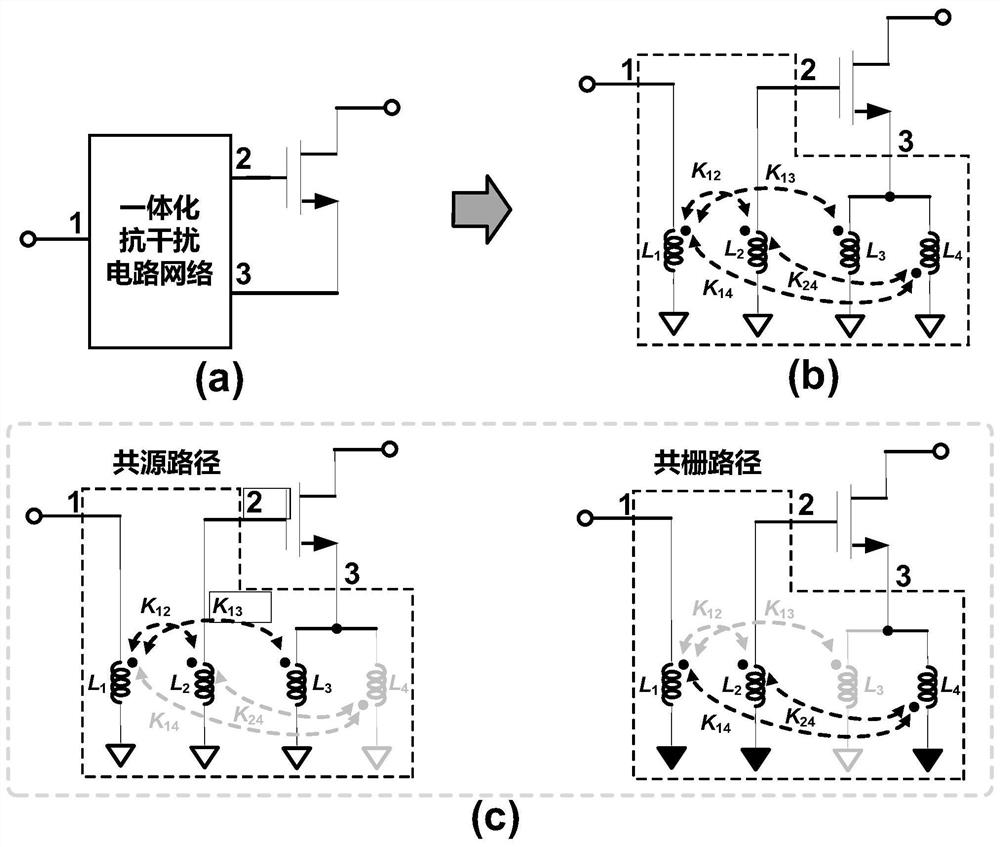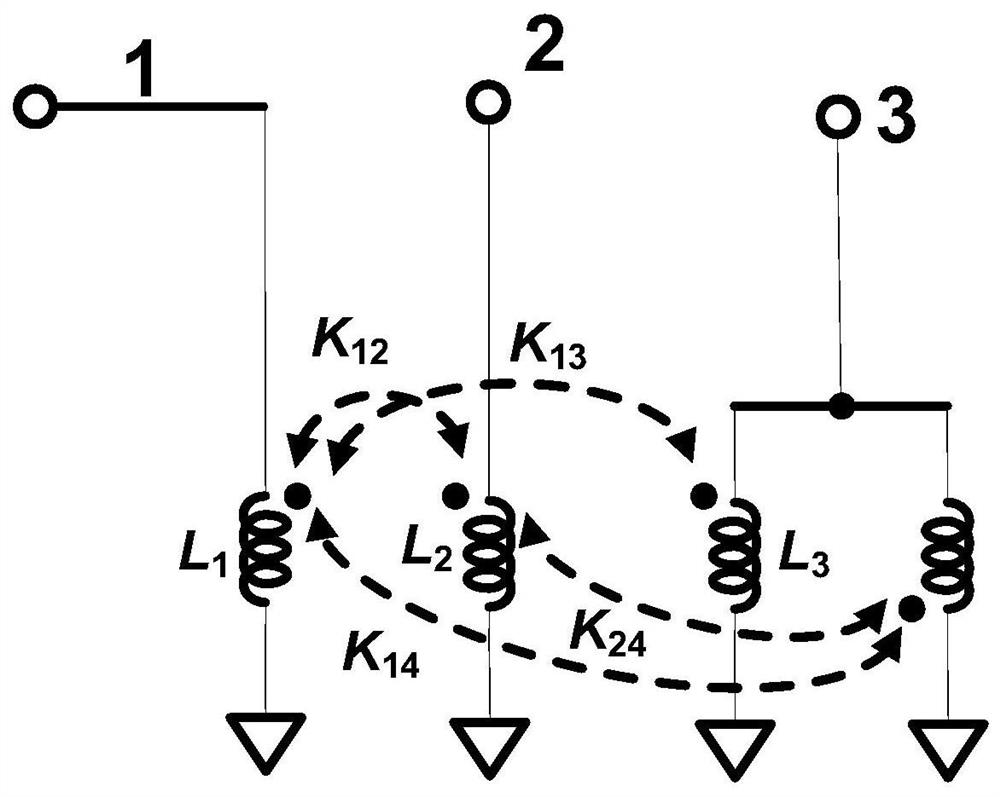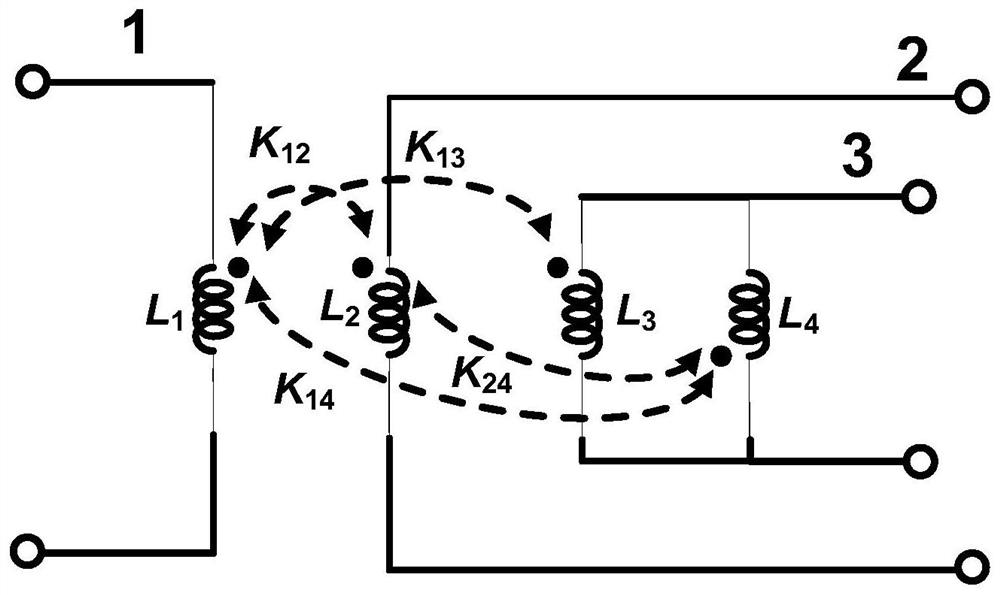An anti-jamming network and its application
A network and inductance technology, which is applied in the direction of amplifier input/output impedance improvement, amplifier improvement to reduce noise impact, amplifier, etc., can solve the problems of deteriorating amplifier noise figure, gain, lack of interference suppression technology, and increasing system complexity, etc., to achieve Achieve the effects of interference signal suppression, novelty, versatility, and compact structure
- Summary
- Abstract
- Description
- Claims
- Application Information
AI Technical Summary
Problems solved by technology
Method used
Image
Examples
Embodiment 1
[0028] Embodiment 1: as figure 2 As shown, the anti-interference network described in the example of the present invention includes four inductance coils, two of which are connected in parallel, and these four inductance coils form a three-port high-order transformer coupling network. The negative terminals of the included first to fourth inductance coils are all connected to the ground terminal. The positive end of the first inductance L1 is connected to the input end, there is a coupling coefficient K12 between the first inductance L1 and the second inductance L2, there is a coupling coefficient K13 between the first inductance L1 and the third inductance L3, and there is a coupling coefficient K13 between the first inductance L1 and the fourth inductance L1. A coupling coefficient K14 exists between the inductors L4, a coupling coefficient K24 exists between the second inductor L2 and the fourth inductor L4, and the third inductor L3 and the fourth inductor L4 are connecte...
Embodiment 2
[0033] Embodiment 2: as Figure 6 As shown, the example of the present invention discloses a single-ended low noise amplifier with a transformer coupling network for interference suppression. Port 1 of the anti-interference network is connected to the input terminal, port 2 is connected to the gate of the first transistor M1, and port 3 is connected to the source of the first transistor M1. The gate of the first transistor M1 is connected to one end of the first resistor R1, and the other end of the first resistor R1 is connected to VB. The drain of the first transistor M1 is connected to one end of the fifth inductor L5, and the other end of the fifth inductor L5 is connected to VDD. One end of the sixth inductor L6 is connected to the gate of the second transistor M2, the other end of the sixth inductor L6 is connected to the ground, and there is a coupling coefficient K56 between the fifth inductor L5 and the sixth inductor L6. The gate of the second transistor M2 is conn...
Embodiment 3
[0034] Embodiment 3: as Figure 7As shown, a differential low noise amplifier with a transformer coupling network for interference suppression disclosed in the example of the present invention, the positive terminal of port 1 is connected to the positive input terminal, the negative terminal of port 1 is connected to the negative input terminal, and the positive terminal of port 2 It is connected with the gate of the first transistor M1, and the negative terminal of port 2 is connected with the gate of the first transistor M2. The positive end of port 3 is connected to the source of the first transistor M1, and the negative end of port 3 is connected to the source of the first transistor M2. The middle taps of the third inductance L3 and the fourth inductance L4 of the parallel inductance in the anti-interference network are grounded, or the middle taps of the third inductance L3 and the middle taps of the fourth inductance L4 are either grounded, and the first inductance of t...
PUM
 Login to View More
Login to View More Abstract
Description
Claims
Application Information
 Login to View More
Login to View More - R&D
- Intellectual Property
- Life Sciences
- Materials
- Tech Scout
- Unparalleled Data Quality
- Higher Quality Content
- 60% Fewer Hallucinations
Browse by: Latest US Patents, China's latest patents, Technical Efficacy Thesaurus, Application Domain, Technology Topic, Popular Technical Reports.
© 2025 PatSnap. All rights reserved.Legal|Privacy policy|Modern Slavery Act Transparency Statement|Sitemap|About US| Contact US: help@patsnap.com



